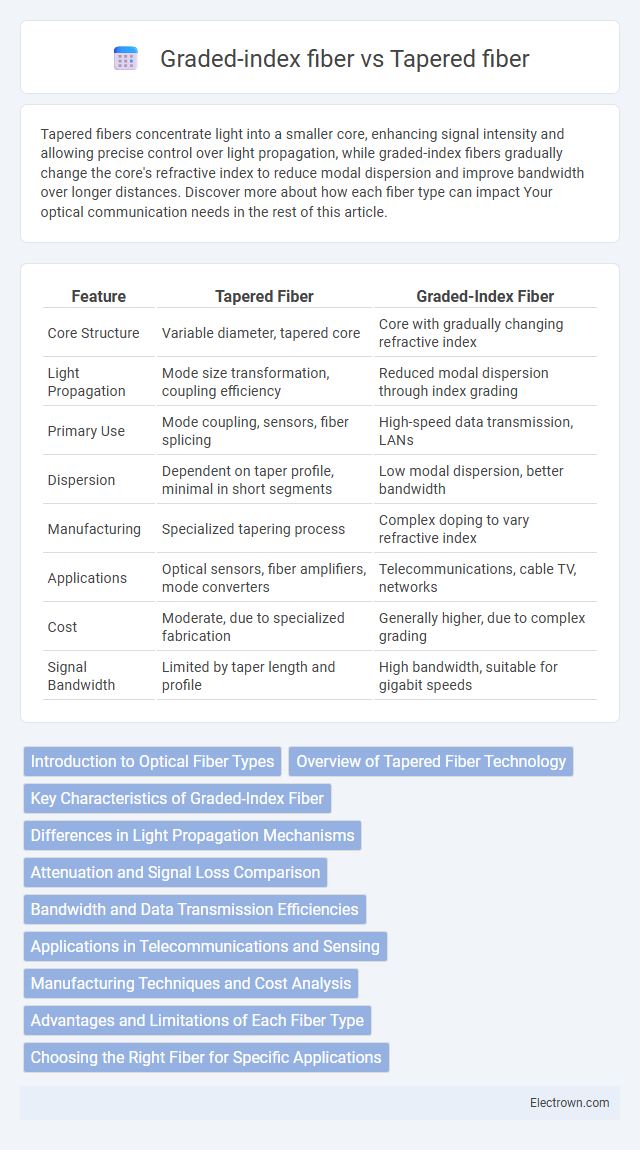Tapered fibers concentrate light into a smaller core, enhancing signal intensity and allowing precise control over light propagation, while graded-index fibers gradually change the core's refractive index to reduce modal dispersion and improve bandwidth over longer distances. Discover more about how each fiber type can impact Your optical communication needs in the rest of this article.
Table of Comparison
| Feature | Tapered Fiber | Graded-Index Fiber |
|---|---|---|
| Core Structure | Variable diameter, tapered core | Core with gradually changing refractive index |
| Light Propagation | Mode size transformation, coupling efficiency | Reduced modal dispersion through index grading |
| Primary Use | Mode coupling, sensors, fiber splicing | High-speed data transmission, LANs |
| Dispersion | Dependent on taper profile, minimal in short segments | Low modal dispersion, better bandwidth |
| Manufacturing | Specialized tapering process | Complex doping to vary refractive index |
| Applications | Optical sensors, fiber amplifiers, mode converters | Telecommunications, cable TV, networks |
| Cost | Moderate, due to specialized fabrication | Generally higher, due to complex grading |
| Signal Bandwidth | Limited by taper length and profile | High bandwidth, suitable for gigabit speeds |
Introduction to Optical Fiber Types
Tapered fibers feature a gradually changing diameter along their length, enabling efficient mode conversion and enhanced coupling between different optical components. Graded-index fibers have a refractive index profile that gradually decreases from the core center to the cladding, reducing modal dispersion and improving signal bandwidth over longer distances. Understanding the distinct optical properties of tapered and graded-index fibers helps optimize Your fiber optic communication system's performance based on specific application requirements.
Overview of Tapered Fiber Technology
Tapered fiber technology involves gradually reducing the fiber diameter to enhance light coupling efficiency, improve mode conversion, and enable precise optical sensing applications. This design contrasts with graded-index fibers, which use a refractive index gradient to minimize modal dispersion and enhance signal transmission over long distances. Understanding these differences allows you to select the appropriate fiber type for optimized performance in telecommunications or sensing systems.
Key Characteristics of Graded-Index Fiber
Graded-index fiber features a core with a refractive index that gradually decreases from the center outward, reducing modal dispersion and improving signal clarity over moderate distances. This design allows light rays to follow curved paths, effectively equalizing travel times and enhancing bandwidth performance compared to step-index fibers. Your network benefits from faster data transmission and lower signal loss when using graded-index fiber for high-speed communication applications.
Differences in Light Propagation Mechanisms
Tapered fibers guide light through a gradually changing diameter that narrows along the fiber length, causing mode transformation and enhanced coupling efficiency. Graded-index fibers feature a refractive index that decreases continuously from the core center to the cladding, enabling light rays to bend smoothly and reduce modal dispersion. Understanding these distinct propagation mechanisms helps optimize Your fiber optic system for specific applications like high bandwidth or minimal signal loss.
Attenuation and Signal Loss Comparison
Tapered fibers exhibit higher attenuation due to mode mismatch and scattering at the taper region, leading to increased signal loss compared to graded-index fibers, which are designed to minimize modal dispersion and maintain lower attenuation. Graded-index fibers feature a refractive index profile that gradually decreases from the core center to the cladding, significantly reducing signal degradation over long distances. In contrast, tapered fibers are typically used for mode coupling or filtering rather than long-distance transmission because their structural changes introduce additional loss mechanisms.
Bandwidth and Data Transmission Efficiencies
Tapered fibers enhance data transmission efficiency by gradually changing the core diameter, reducing modal dispersion and enabling higher bandwidth over longer distances. Graded-index fibers optimize bandwidth by varying the refractive index radially, minimizing modal delay differences and supporting higher data rates in multimode transmission. Both fiber types improve signal integrity, but graded-index fibers typically offer superior bandwidth performance in short to medium-range communication systems.
Applications in Telecommunications and Sensing
Tapered fibers enhance sensitivity in optical sensors by concentrating light into a smaller cross-section, making them ideal for precise environmental monitoring and biochemical detection in telecommunications networks. Graded-index fibers reduce modal dispersion, improving bandwidth and signal quality over long distances, which is crucial for high-speed data transmission in telecommunication infrastructure. Your choice between these fibers depends on whether maximizing sensor accuracy or optimizing communication efficiency is the primary goal.
Manufacturing Techniques and Cost Analysis
Tapered fibers require precise heating and stretching processes to gradually reduce the fiber diameter, making their manufacturing more complex and labor-intensive compared to graded-index fibers, which use controlled doping concentration profiles during preform fabrication. The cost of tapered fibers is generally higher due to specialized equipment and skilled labor needed for tapering, whereas graded-index fibers benefit from established mass-production techniques, resulting in lower unit costs. Your choice between these fibers should consider the trade-off between performance benefits and the cost implications of their manufacturing techniques.
Advantages and Limitations of Each Fiber Type
Tapered fiber offers advantages such as reduced mode coupling losses and enhanced light confinement, enabling efficient signal transmission in compact optical devices, but its fabrication complexity and sensitivity to environmental factors limit widespread usage. Graded-index fiber provides improved bandwidth and reduced modal dispersion by gradually varying the refractive index, making it ideal for high-speed communication over moderate distances, though it suffers from higher attenuation compared to single-mode fibers. Both fiber types serve distinct roles in optical communication systems, balancing trade-offs between performance, cost, and application-specific requirements.
Choosing the Right Fiber for Specific Applications
Tapered fibers excel in applications requiring precision light manipulation and mode conversion, offering enhanced control over beam shape and coupling efficiency. Graded-index fibers are optimal for high-speed data transmission over moderate distances due to their reduced modal dispersion and improved signal integrity. Selecting between tapered and graded-index fibers depends on the specific requirements for bandwidth, distance, and light propagation characteristics in the intended application.
Tapered fiber vs Graded-index fiber Infographic

 electrown.com
electrown.com